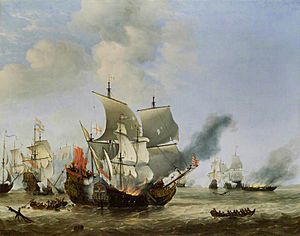English ship St Andrew (1622) facts for kids

The Burning of the Andrew at the Battle of Scheveningen in 1653, by Willem van de Velde the younger
|
|
Quick facts for kids History |
|
|---|---|
| Name | St Andrew |
| Builder | Burrell, Deptford |
| Launched | 1622 |
| Commissioned | 1623 |
| Fate | Driven ashore and wrecked near Rye, East Sussex, September 1666 |
| General characteristics | |
| Class and type | 42-gun great ship |
| Tons burthen | 587 |
| Length | 110 ft (34 m) (keel) |
| Beam | 37 ft (11 m) |
| Depth of hold | 16 ft 6 in (5.03 m) |
| Sail plan | Full-rigged ship |
| Complement | 280 (peacetime), 360 (active service) |
| Armament | Originally 42 guns of various weights of shot, increased to 66 in 1666 |
The St Andrew, also known as the Andrew, was a powerful warship from England. It was a "great ship," which meant it was a large and important vessel for its time. Built by Andrew Burrell in Deptford, this ship was launched in 1622. It started with 42 guns, but later had even more.
Contents
Early Voyages and First Battles
The St Andrew first sailed into action in 1625. It was part of a big group of ships sent to Cádiz in Spain. This was one of its first important missions.
Joining the English Civil War
In August 1642, a big conflict started in England. This was the First English Civil War. It was a fight between the Parliament and King Charles I. The St Andrew was taken over by Parliament during this time.
During the war, the ship was usually called the Andrew. It helped Parliament's forces along the coast. For example, it supported attacks on places like Pendennis Castle in Cornwall. This castle was one of the last places still loyal to the King. The ship played a role in helping Parliament gain control of these areas.
A Change of Name
After the war, in 1660, the King was put back in charge of England. This event is called the Stuart Restoration. After this, the ship went back to being called the St Andrew.
Later Wars and Final Days
The St Andrew continued to serve in important battles. It fought in the First Anglo-Dutch War. This was a series of naval battles against the Dutch.
Damage and Upgrades
Later, the ship was badly damaged during the Second Anglo-Dutch War. After this, it was repaired and made even stronger. Its number of guns was increased from 42 to 66. This made it a very powerful warship.
The End of the St Andrew
On September 3, 1666, a big storm hit. The St Andrew was driven ashore near Rye, East Sussex. It was stuck on the land. People decided that fixing the ship would cost too much money. So, about two months later, its useful parts were removed. The ship was then broken up and no longer sailed.

